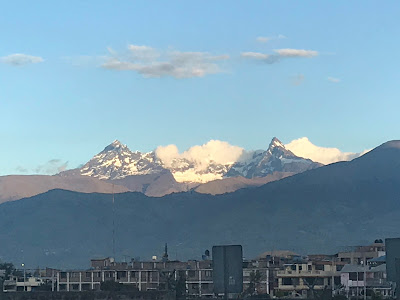El Altar, a group of nine summits connected by the same base, is one of the most iconic mountains of Ecuador. For local climbers, its ascent represents the entry exam to the “real deal” league. This “little” range presents an espectacular combination of intimidating cliffs, long ice waterfalls and broken glaciers, all surrounded by remote highlands and hidden lakes. It is no wonder the indigenous and the spanish culture, always treated the mountain with the respect reserved for the divine.
These nine peaks are lined up in a horseshoe shape facing the open caldera to the west, towards the city of Riobamba. The Obispo is the tallest of those summits. It rises high on the south end and offers no easy way to the top. It took the Italians Ferdinando Gaspard, Marino Tremonti and Claudio Zardini 10 days to determine a possible line for conquering the summit on July 7th of 1963. This was certaintly quite late in the history of alpinism.
Nowadays, climbing Obispo is still not an easy task. After dealing with a 4X4 road that ends at the Bocatoma de Ingisay, climbers have to hire mules to transport the equipment and then approach by muddy trails for six hours to the base camp. Most of the times this is done in rainy conditions. The mountain is so close to the amazonian basins where convection works fast and confirms, more than other peaks, the established saying: “if you don’t like clouds, you have no business in Ecuador”.
Robert R. a long time MM climber, learned that well eleven years ago, on his first trip to the volcanoes of the middle of the world. That time, the weather didn’t work to the advantage of the climbers and they were able to reach only one of the three attempted mountains. Te purpose of the trip was a mountaineering school trip so the goal was still completed. The participants incorporated the necessary skills for enjoying the high mountains and in the case of Robert, that experience lead him to climb many other summits in the andes throughout this years. Now he came back to Ecuador for his well deserved chance on El Altar.
From the base camp, the route navigates by class 3 to 4 terrain to the entrance of the glacier. Then, a traverse to the east beneath the secondary summits of Pulpito and Carmelo is necessary to arrive to the beginning of the climb. A couple of pitches on steep snow lead to the first rock band and on the higher part, some mix terrain has to be negotiated to arrive at the Calvario ridge. After this, it's necessary to navigate the second (hanging) glacier in order to access the final gully.
Until this point, the climb is delicate but nothing is new for Robert. He has accumulated enough -TD- ascents in Peru and Bolivia to deal with the climb calmly. However, the Obispo has a final challenge near the summit. Two pitches of loose vertical rock are the gate to the top. The crampons scratches the rock and the hands seek for tiny corners to hold onto and progress. The view is jaw dropping. To the left, the 1000 meter cliff of the north face of the peak drops aggressively and the direct view into the caldera is intimidating.
The effort pays off. The Mountains Madness team reaches the summit to enjoy a magical morning. From the top its possible to see Canonigo on the north side of the massif, and in the distance, Chimborazo and Cotopaxi. To the east, a mattress of clouds make the team feel taller than anything and they allow themselves a moment of pure joy. However, those clouds are also a silent reminder. The game is not over, it’s important to set up the rapels and quickly descend to the tents before a storm arrives.
Back in the camp, the arriero’s (mule driver) dog has been waiting for the team. He is happy seeing people back. They represent the meal of the day, and for the climbers it’s a way to materialize that they have touched the “altar” of gods and came back to the world of humans.




No comments:
Post a Comment